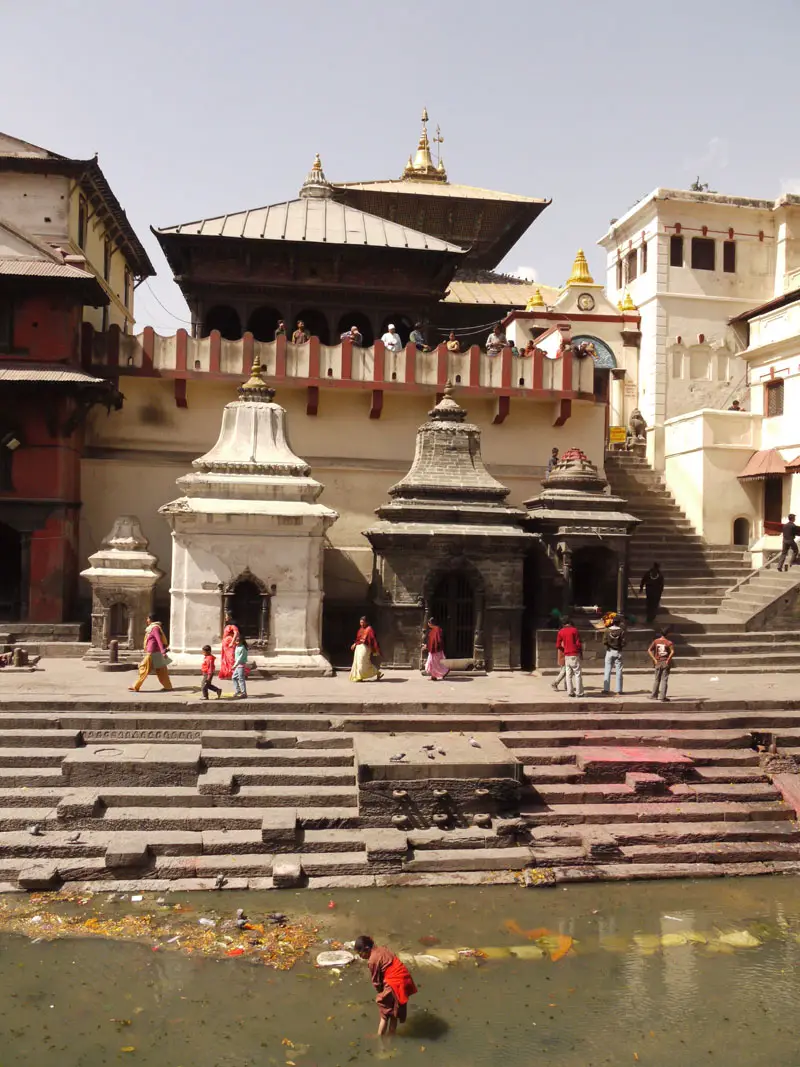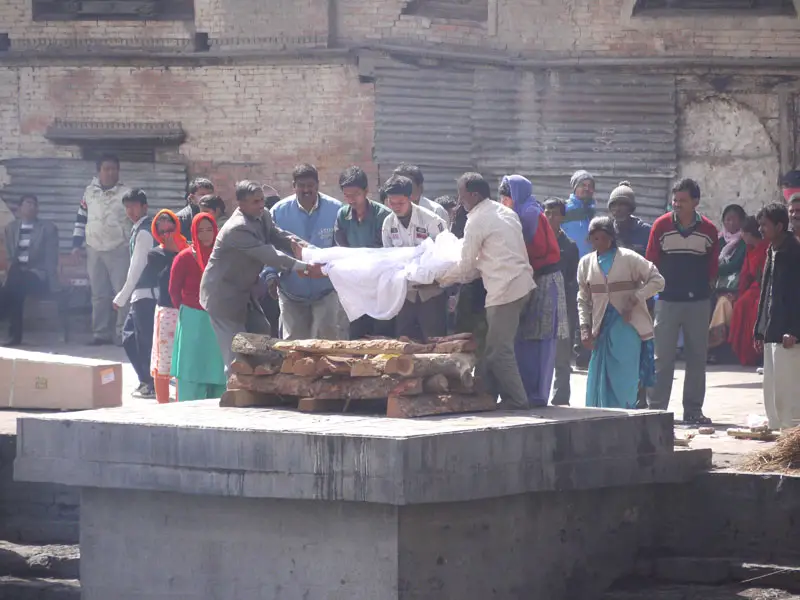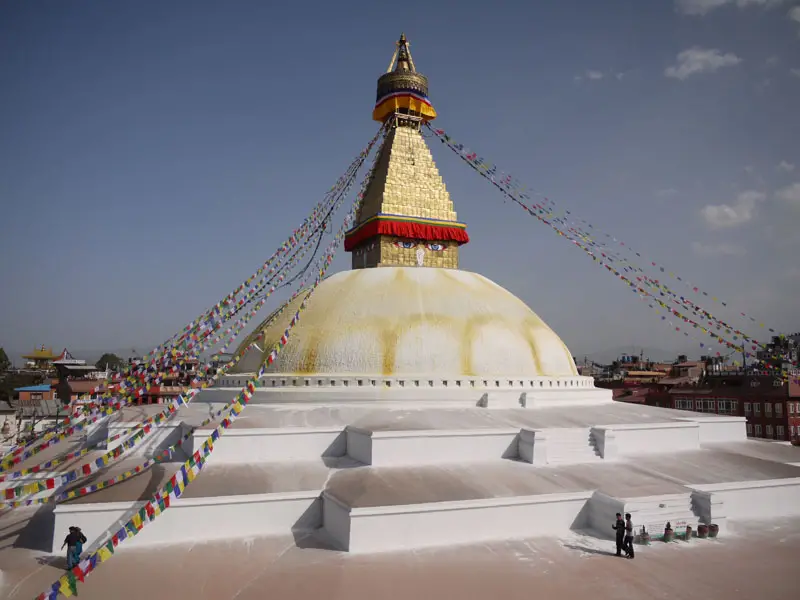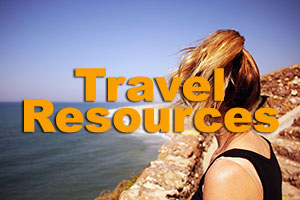The Bagmati river in Pashupatinath just outside of Kathmandu is the Nepali equivalent of Varanasi on the River Ganges in India. We were very interested to see the ghats along the river where the cremations at Pashupatinath take place. I had seen these ceremonies on television but still, I didn’t really know what to expect.
Cremations at Pashupatinath
The taxi from Kathmandu only took about twenty minutes to reach Pashupatinath. We walked slowly through a kind of market that was selling flowers, knick-knacks and of course the coloured paints for the Holi celebration, to begin the next day.
We wandered on until we reached the gate of a big complex. There was a very relaxed vibe about the place. There were two holy men sitting together on a wall, school children covered in red paint running around and big bulls freely strolling around the grounds. A big Hindu temple stood at one end of the grounds but we were stopped from going in because we were not Hindu. A quick walk up onto the edge of the hill and we at least got some views of the inside of the temple. Most impressive was the huge gold-plated cow in the centre and the smaller solid gold cow sitting in front of it, glinting in the sunlight.
The temple backed onto the Bagmati river, our next stop. It was hard to believe that this river was so sacred, I mean if something really was that sacred I would have assumed it would have been well looked after. The water was filthy and full of rubbish. There were some children wading through the mess trying to find coins. One boy was very inventive; fishing for coins with a magnet on a string, he wasn’t having much success though.

The ghats at the back of the temple complex in Pashupatinath and a young girl looking for coins in the river
The ceremony
There were two crowds gathering, one at either side of the bridge. We crossed over the bridge and turned to face the ghats on the opposite bank. There was a pile of wooden logs neatly stacked in one of the ghats and the family of the deceased appeared from a doorway behind.The body was laid out on the ground and wrapped carefully in a white sheet by members of the family The wrapped body was then lifted and placed gently on the stack of logs. Two young guys, who seemed to be organising the cremations, came in and placed some extra logs across the top of the body. A man from the congregation stepped up to the body and fell to the ground in what came across as a theatrical part of the ceremony, which I could only assume was to show how grief-stricken he was at his loss.
The two young men who had been down in the river soaking straw, arrived back to place it over the top of the deceased. Incense was lit and eight or so family members walked slowly clockwise around the body, each person waving incense. A real sombre mood came over the spectators on our side of the river as one of the young men proceeded to light the stack of wood which now completely hid the body. Smoke filled the air, as did the wails of some of the women and the family stepped back to sit and pray for the deceased.
Powerful
As one cremation was taking place, I couldn’t help but notice that the ghat next door was being set up for another cremation. As the family took a few steps back at the end of the ceremony a box containing another body arrived down to be cremated at the next ghat. Even though the ceremony was very heartfelt and quite powerful, there was still a certain efficiency about how these cremations took place.
Bodnath Stupa
Bodnath was our next stop and leaving the smoky river behind we began walking north. The walk to Bodnath took about twenty minutes and we passed through some small towns and temples on the way. We also observed our first Nepali golfer out in the middle of a big field with a single club and a ball, and not a fairway or a green in sight!
A few wrong turns later we eventually saw the gold stupa appear over the rooftops. Heading straight for it, we stumbled across Bodnath’s main street and the entrance to the temple. A giant white dome with a large gold pillar-like construction on top, depicting the eyes of the Buddha looked down on us. Buddhist monks and pilgrims filled the square walking clockwise around the stupa, turning prayer wheels, lighting butter lamps and ringing the bells they passed as they circled the massive stupa.
Around the stupa there were a number of monasteries (Gompas) where young buddhist monks come to study, chant and pray. People come from all over to study at these monasteries, we even saw a few westerners sporting the maroon coloured robes and shaved heads. Not for me though, maroon isn’t really my colour!

Brian is a travel writer, photographer, blogger, travel addict and adventure-junkie. Being outdoors, getting off the beaten track and outside his comfort zone is what makes him tick. Brian’s the dreamer in the relationship; when he’s not travelling, he’s dreaming about it! Keeping fit, cooking, music and red wine take up the rest of his time.
Sign up for our free travel photography Ebook "Faces of Nepal" and you'll also receive our monthly newsletter.







